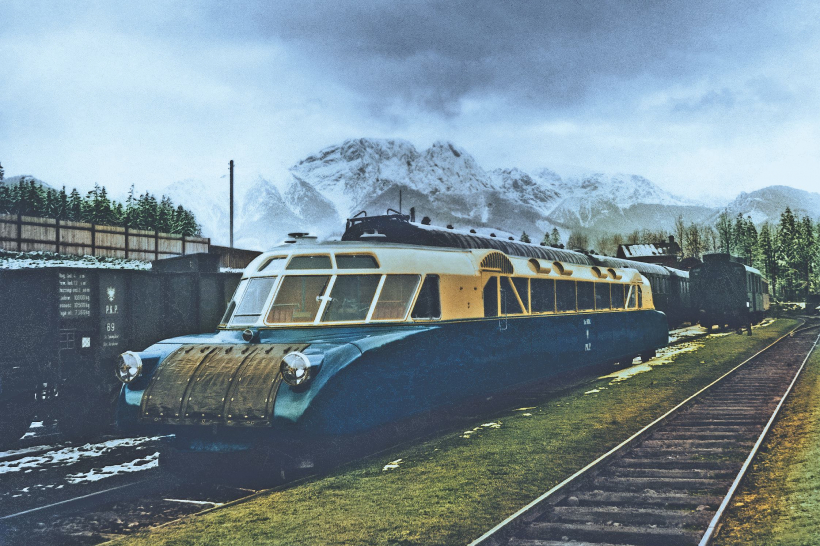
Luxtorpeda zwana torpedą podhalańską - koniec lat 30. XX w. / A Luxtorpeda called the "Podhale torpedo" - late 1930s
Historia kolei
10 listopada 2020

Luxtorpeda zwana torpedą podhalańską - koniec lat 30. XX w. / A Luxtorpeda called the "Podhale torpedo" - late 1930s
Ministerstwo Kolei Żelaznych
We wrześniu 1918 roku przystąpiono w Polsce do zorganizowanego przejmowania sieci kolejowej z rąk zaborców. Sekcja Kolejowa przy Polskim Ministerstwie Przemysłu i Handlu miała przejąć linie administrowane dotąd przez niemiecką Wojskową Dyrekcję Kolejową w Warszawie i austriacką Wojskową Dyrekcję Kolejową w Radomiu. Na terenie zaboru rosyjskiego działało w tej sprawie Stowarzyszenie Wzajemnej Pomocy Pracowników Kolejowych we współpracy z Polską Organizacją Wojskową. Na obszarach objętych walkami po zajęciu linii kolejowych przez oddziały wojskowe zarządzanie należało do Ministerstwa Komunikacji. Ostatecznie sieć ta została przejęta po zakończeniu wojny polsko-bolszewickiej na podstawie traktatu ryskiego z 1921 roku.
W październiku 1918 roku Rada Regencyjna powołała w Warszawie Ministerstwo Komunikacji z sekcją kolejową, przekształconą 8 lutego 1919 roku w Ministerstwo Kolei Żelaznych. Z początkiem 1921 roku ministerstwo dzieliło się na siedem departamentów i cztery samodzielne wydziały. Sejm powołał Państwową Radę Kolejową, opiniującą i nadzorującą rozwój sieci, zmiany taryf, przepisów i regulaminów, oraz Radę Techniczną.
Artykuł 371 traktatu wersalskiego z 28 czerwca 1919 roku stanowił, że urządzenia wszystkich kolei na obszarze na wschód od wytyczonej granicy polsko-niemieckiej przypadły Polsce. Zastosowano to także do linii na terenach zaboru rosyjskiego przekutych na tor o szerokości normalnej, które zostały przejęte przez Niemców w wyniku działań wojennych. Dodatkowo konwencja polsko-gdańska z listopada 1920 roku oddawała Rzeczypospolitej administrowanie kolejami na obszarze Wolnego Miasta Gdańska. Z powodu napiętej sytuacji i rozruchów rewolucyjnych na ziemiach dawnego zaboru pruskiego musiano przerwać połączenie Wielkopolski z Berlinem, a Komisariat Naczelnej Rady Ludowej w Poznaniu wezwał Polaków do zajmowania linii kolejowych i obsadzania stanowisk. Trwało to do kwietnia 1920 roku, bowiem na Pomorzu pracownicy niemieccy musieli pozostać w służbie z braku polskiej obsady.
Podnoszenie z ruin
Polska przejęła 4228 kilometrów linii kolejowych z terenu byłego zaboru pruskiego, 4357 kilometrów z zaboru austriackiego i 7362 kilometry z zaboru rosyjskiego. Otrzymaliśmy 4762 parowozy 164 typów, 10 379 wagonów osobowych i 111 092 wagony towarowe. Większość prezentowała zły lub fatalny stan techniczny. Sieć kolejowa na terenie nowo powstałego państwa była zrujnowana. Podczas wojny zaborcy zniszczyli 41% mostów, 63% dworców, 31% magazynów, 48% warsztatów i parowozowni, 81% stacji wodnych i wież ciśnień, a także 22% domów mieszkalnych. Wywieźli urządzenia, maszyny i surowce konieczne do funkcjonowania kolei. Traktat wersalski nie przewidział dla Polski odszkodowań z tego tytułu. Największe zniszczenia odnotowano na terenie nowych dyrekcji: wileńskiej, warszawskiej, radomskiej, lwowskiej i stanisławowskiej. Ministerstwo Kolei Żelaznych przystąpiło do budowy prowizorycznych drewnianych mostów, zastępując je stopniowo konstrukcjami stalowymi z wykorzystaniem elementów nadających się do powtórnego użycia. Proces odbudowy trwał właściwie przez całe międzywojnie.
Pierwsza polska szyna kolejowa
Po zaborcach pozostało w torach 66 typów szyn o różnej jakości i stopniu zużycia. Pierwsze dostawy nowych szyn i złączek zamówiono w Belgii w 1922 roku, a od 1923 roku uruchomiono dostawy z czterech hut na Górnym Śląsku. Dopiero w drugiej połowie lat 20. XX wieku wprowadzona została pierwsza polska szyna – S26 (o masie 42,5 kg/mb). Ujednolicono konstrukcje złączek szynowych, wprowadzone zostały wytrzymalsze stale do wyrobu elementów torowisk. Huty dostarczały szyny o długościach 12 i 18 metrów, a od 1938 roku – 30 metrów. W dwudziestoleciu międzywojennym wymieniono wszystkie podkłady w torach, to znaczy ułożono 50 milionów sztuk nowych podkładów kolejowych! Była to gigantyczna praca. Stosowano coraz częściej pośrednie mocowanie szyn: najpierw śrubami do podkładek, a następnie podkładki mocowane były do podkładów.
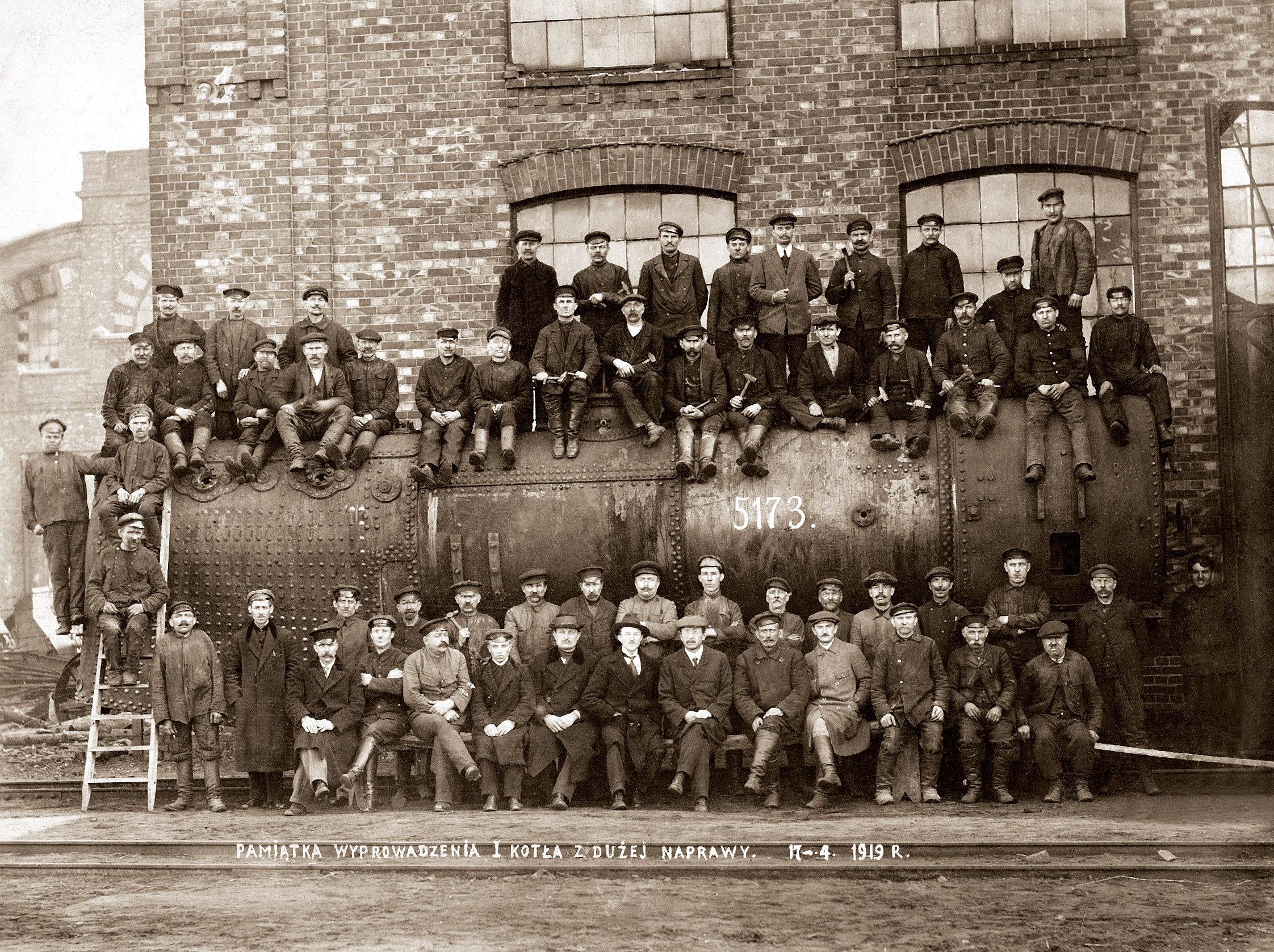
Fotografia upamiętniająca wyprowadzenie pierwszego kotła parowozu z naprawy - 1919 r. / A photograph commemorating the delivery of the first steam boiler after repair - 1919
Pierwsze struktury Polskich Kolei Państwowych
W każdym z zaborów obowiązywały odmienne przepisy ruchu i sygnalizacji, na przykład w zaborze austriackim ruch pociągów był lewostronny i odbywał się w odstępie czasu, podczas gdy w zaborze pruskim w odstępie drogi. Każdy z zaborów miał inną sygnalizację kolejową oraz różnorodne urządzenia zabezpieczenia ruchu pociągów. We wrześniu 1926 roku prezydent RP powołał przedsiębiorstwo Polskie Koleje Państwowe, które przejęło zarząd i użytkowanie nieruchomości należące do kolei, a na własność cały majątek ruchomy.Sama organizacja służb była nieco odmienna w każdym z byłych zaborów. Dopiero w 1931 roku wprowadzono jednolitą strukturę z podziałem na oddziały ruchowo-handlowe, drogowe i mechaniczne. Powstały jednostki centralne, takie jak: Biuro Studiów i Projektów Kolei Państwowych (1926), Centralne Biuro Obrachunków Wagonowych, Centralne Biuro Zaopatrzenia Materiałowego Kolei Państwowych, Biuro Elektryfikacji Warszawskiego Węzła Kolejowego i Biuro Komunikacji Samochodowej Polskich Kolei Państwowych. W 1934 roku powołano Straż Ochrony Kolei.
Lokomotywy z różnych stron świata
Potrzeby kolejnictwa i brak możliwości własnych dostaw skłoniły władze kolejowe do zakupu w amerykańskich zakładach Baldwina 175 parowozów typu 7001 (Tr20), 100 poniemieckich maszyn (19 Ok1, 80 Tp3 i 1 Om101) we Francji, 165 parowozów w Niemczech, 186 w Austrii, 100 w Belgii i 41 w innych krajach. Do tego 301 wagonów osobowych i 15,5 tys. wagonów towarowych, wśród nich czteroosiowe amerykańskie wagony kryte, węglarki i platformy.
Nasze polskie wagony
Już w 1919 roku rząd podjął decyzję o budowie trzech zakładów produkujących wagony kolejowe i trzech – parowozy, gwarantując przedsiębiorcom długoletnie zamówienia. W Ostrowie Wielkopolskim w latach 1920–1921 powstała Fabryka Wagonów L. Zieleniewski, wykupiona w 1927 roku przez państwo i przemianowana na Warsztaty Wagonowe (po II wojnie światowej – Zakład Naprawczy Taboru Kolejowego „Ostrów”). Produkcji wagonów (krytych i do przewozu ryb żywych) podjęła się w 1921 roku Spółka Akcyjna Wielkich Pieców i Zakładów Ostrowieckich w Ostrowcu Świętokrzyskim. Fabryka wytwarzała także pługi odśnieżne, żurawie kolejowe, lokomotywki, części do parowozów, samochodów, czołgów, armat oraz konstrukcje stalowe. Na zamówienie sowiecko-polskiej misji handlowej zbudowano tam w 1932 roku 36 wagonów samowyładowczych do przewozu rudy magnezytowej, była to nowatorska konstrukcja inżyniera Mieczysława Radwana.
Oddział produkcji wagonów w Chorzowie działał od 1895 roku w spółce Zjednoczone Huty Królewska i Laura (po II wojnie światowej – Konstal). Firma dostarczała w okresie międzywojennym głównie wagony towarowe: węglarki, kryte, platformy, pocztowe, cysterny do piwa, garnkowe do kwasów, do nafty, smoły, do transportu bydła, wagony do transportu rozżarzonych bloków i kęsów dla hut, a także tramwaje.
Pierwsza Fabryka Lokomotyw
W kraju nie było zakładów budujących parowozy. Dlatego powstała Warszawska Spółka Akcyjna Budowy Parowozów, a w Chrzanowie Pierwsza Fabryka Lokomotyw w Polsce Spółka Akcyjna. W Chrzanowie, jeszcze w trakcie budowy fabryki, przystąpiono do montażu parowozów serii Tr21 z części i według projektu sporządzonego w wiedeńskich zakładach Staats-Eisenbahn-Gesellschaft (StEG). Kotły dostarczał Fitzner i Gamper z Sosnowca. Pierwszy zmontowany parowóz wyjechał z zakładu 7 kwietnia 1922 roku, natomiast pierwsza lokomotywa wykonana z podzespołów krajowych – w lutym 1924 roku. Oprócz tego w Chrzanowie wytwarzano parowozy wąskotorowe, spalinowozy, lokomotywy na eksport do Maroka, Bułgarii, Litwy, Łotwy i ZSRR, rotacyjne pługi odśnieżne dla PKP, spalinowe walce drogowe, drezyny.
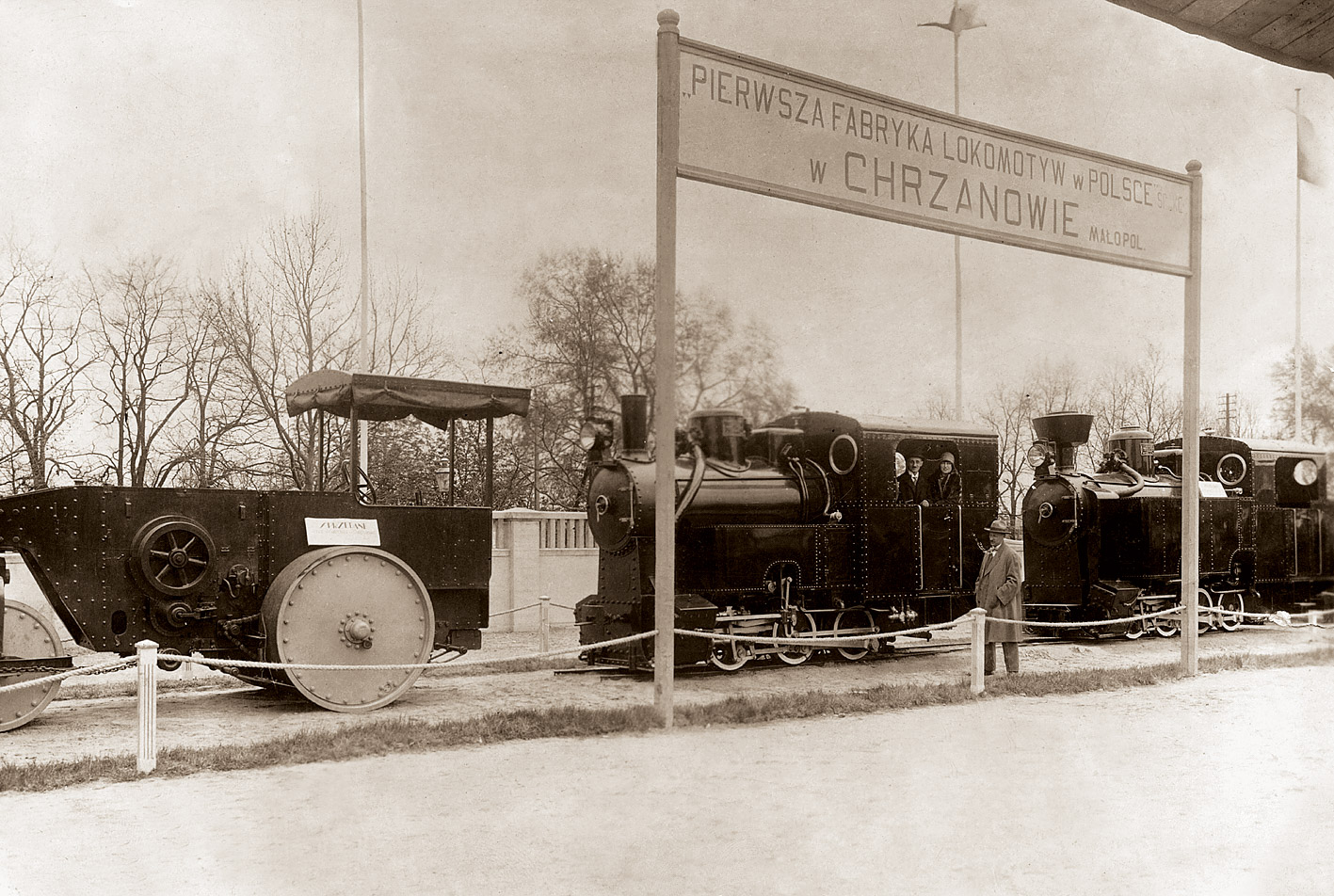
Pierwsza Fabryka Lokomotyw w Chrzanowie - lata 20. XX w. / The First Steam Locomotive Factory in Chrzanów - the 1920s
Również Cegielski produkuje lokomotywy
W 1926 roku do produkcji parowozów (serii Ty23, OKl27, Pu29, OKz32, Ty37) przystąpiły także Zakłady Mechaniczne Hipolita Cegielskiego w Poznaniu, firma z 75-letnią tradycją. Do 1939 roku „Cegielski” wyprodukował 341 lokomotyw dla PKP i 13 na eksport. W zakładach budowane były także różnego typu wagony towarowe: kryte, węglarki, platformy, chłodnie, świniarki, cysterny dwu- i czteroosiowe, garnkowe do kwasów, cysterny do chloru, sześcioosiowe platformy zagłębione, wagony do przewozu żywych ryb. Od 1928 roku firma produkowała również wagony sypialne i restauracyjne.
Warszawska Spółka Akcyjna Budowy Parowozów (WSABP) zajęła się montażem austriackich lokomotyw serii 270 (Tr12 oraz Ty23). W marcu 1924 roku fabrykę opuścił pierwszy Tr12, zmontowany z części wykonanych w kraju. W następstwie kryzysu gospodarczego WSABP została wykupiona w 1934 roku przez Zakłady Ostrowieckie, które przemianowały ją na Wytwórnię Parowozów Zakładów Ostrowieckich. Utrzymano tam produkcję lokomotyw parowych (łącznie Wytwórnię opuściło 320 sztuk) i wagonów motorowych wąskotorowych oraz kotłów parowozowych.
Wybitni polscy konstruktorzy
Produkcja taboru i urządzeń dla kolejnictwa nie byłaby możliwa bez doświadczonych inżynierów, kierujących biurami konstrukcyjnymi i zakładami wytwórczymi. Kolejnictwo polskie w okresie międzywojennym dysponowało znakomitą kadrą, wykształconą na uczelniach europejskich i rosyjskich. Wśród konstruktorów parowozów wyróżniali się profesorowie: Antoni Xiężopolski (1861-1951) – twórca Pt31, OKz32, Pm36, Ty37; Albert Czeczott (1873-1955) – szef samodzielnego referatu doświadczalnego przy departamencie mechanicznym Ministerstwa Komunikacji; Franciszek Tatara (1903-1984) – posiadacz patentu na wyrównywacze ciśnienia; Kazimierz Zembrzuski (1905-1981) – konstruktor i teoretyk budowy parowozów; Adolf Langrod (1876-1968) – konstruktor i teoretyk budowy parowozów, wagonów, hamulców i sieci trakcyjnej.
Spośród budowniczych i projektantów linii kolejowych warto wspomnieć Stanisława Rawicz-Kosińskiego (1847-1923) – budowniczego linii w Galicji, Józefa Nowkuńskiego (1866-1952) – budowniczego linii Kalety-Podzamcze oraz magistrali węglowej Śląsk-Porty, Aleksandra Wasiutyńskiego (1859-1944) – twórcy typoszeregu szyn dla kolejnictwa rosyjskiego, projektanta i budowniczego warszawskiej linii średnicowej, Romana Podoskiego (1873-1954) – pioniera elektryfikacji kolei.
Systemy kąpielowe i inne Polskie innowacje
Polska myśl techniczna wniosła do kolejnictwa wiele twórczych i innowacyjnych rozwiązań. Wśród nowatorskich konstrukcji można wspomnieć łożyska osiowe systemu zaprojektowane przez inżyniera Marcina Czarkowskiego (1869-1936); hamulce przestawne autorstwa inżyniera Henryka Suchanka, umożliwiające podłączanie pojazdu w nie wyposażonego do hamulców próżniowych Hardy’ego, jak i do hamulców ciśnieniowych; system klimatyzacji wagonów restauracyjnych konstrukcji inżyniera Stanisława Rodowicza; system chłodniczy profesora Stanisława Sokołowskiego. Natomiast polski parowóz Pm36 w otulinie aerodynamicznej otrzymał złoty medal na Międzynarodowej Wystawie „Sztuka i Technika w życiu współczesnym” zorganizowanej w 1937 roku w Paryżu. Doczepiony do parowozu pociąg turystyczny, złożony z wagonów: sypialnego II i III klasy, kąpielowego i barowego nagrodzono wyróżnieniem. W sumie skonstruowano w Polsce dziewięć serii parowozów z najlepszymi rozwiązaniami, wprowadzono także szybkościomierze, centralne smarowanie, system zwalczania kamienia kotłowego, poprawę spalania węgla. Znacznej poprawie uległa ponadto wydajność kotłów i ograniczono dymienie.
Do 1939 roku wyprodukowano w polskich zakładach 959 wagonów osobowych czteroosiowych i 665 dwu- i trzyosiowych. Ponad 900 wagonów pochodziło z importu. Spośród 153,3 tys. wagonów towarowych, które jeździły po szlakach kolejowych II Rzeczypospolitej, 45 tys. dostarczyły polskie wytwórnie. Naprawami zajmowały się warsztaty główne Polskich Kolei Państwowych w Brześciu, Bydgoszczy, we Lwowie, w Łapach, Nowym Sączu, Ostrowie Wielkopolskim, Piotrowicach Śląskich, Poznaniu, Radomiu, Pruszkowie, Stanisławowie, Stryju, Tarnowie, Tczewie, Warszawie-Pradze i Warszawie Wschodniej.
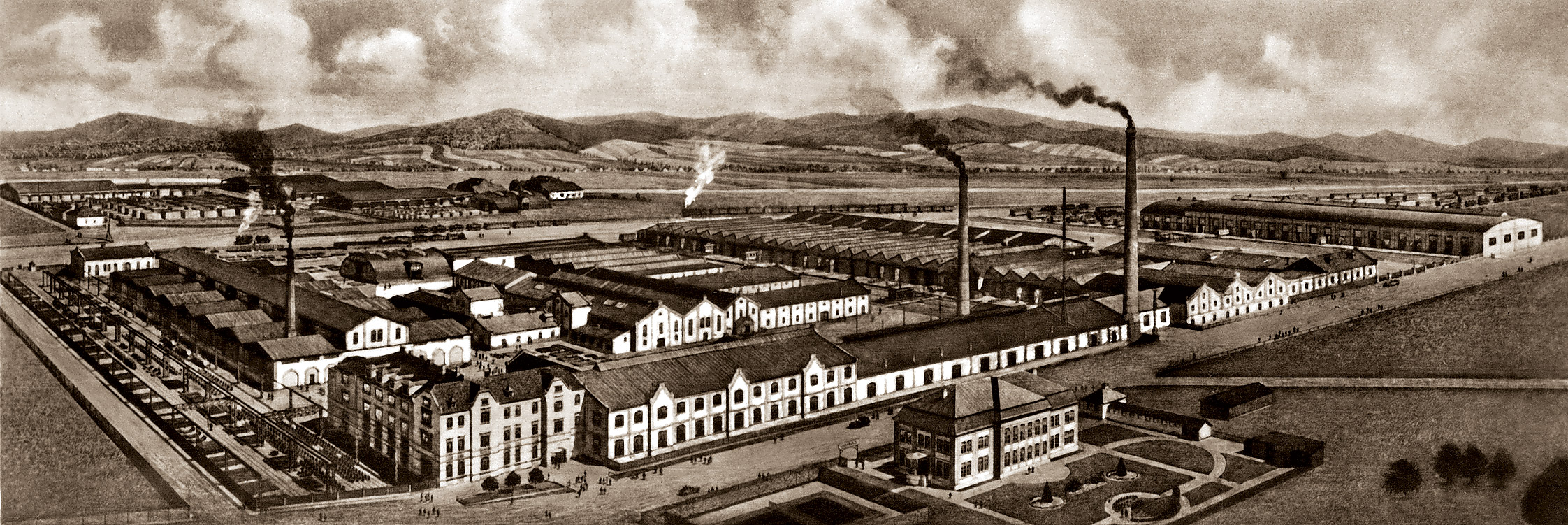
Rycina prezentuje fabrykę L. Zieleniewskiego w Sanoku / A drawing of the L. Zieleniewski Factory in Sanok
Nowe połączenia kolejowe
Po scaleniu trzech sieci kolejowych w jeden organizm, brak było bezpośrednich połączeń między ważnymi ośrodkami gospodarczymi: Śląska i Krakowa ze stolicą i Wybrzeżem, Wielkopolski ze stolicą, a także połączeń lokalnych po obu stronach starych granic pomiędzy zaborami. Jednymi z pierwszych nowo zbudowanych linii były: Kutno-Koło-Konin-Strzałkowo (1921), która skracała przejazd z Poznania do Warszawy, i Gdynia-Kokoszki (1921), omijająca teren Wolnego Miasta Gdańska. Połączono także Puck z Helem. Na Górnym Śląsku powstały łącznice: Hajduki-Kochłowice (1924), omijająca niemiecki węzeł w Gliwicach, Makoszowy-Mizerów (1924), Brzezie-Bluszczów (1925), umożliwiająca połączenie sieci polskich kolei z zachodnią częścią Górnego Śląska, Pawłowice Śląskie-Chybie (1924), Chorzów-Szarlej (1925), stanowiąca objazd węzła bytomskiego. Wojskową linię wąskotorową Nasielsk-Sierpc zamieniono na normalnotorową (1924).
Węgiel ze Śląska na północ kraju jechał długą trasą przez Częstochowę i Warszawę. Stacje na dawnej Drodze Żelaznej Warszawsko-Wiedeńskiej nie miały niestety przepustowości mogącej zapewnić sprawny ruch pociągów. Rozbudowano więc najpierw stacje w Częstochowie i Łazach. Pociągi z Górnego Śląska do Wielkopolski przejeżdżały tranzytem przez terytorium Niemiec linią Lubliniec-Olesno-Kluczbork, co znacznie podnosiło koszty transportu. Trwająca od 1925 roku wojna celna Polski z Niemcami przyspieszyła decyzję o budowie linii Kalety-Herby-Wieluń-Podzamcze, biegnącej dalej przez Kępno do Wielkopolski. Licząca 114 kilometrów jednotorowa linia (chociaż przygotowano trasę pod zabudowę drugiego toru) z ośmioma stacjami i mijanką, zaprojektowana przez zespół młodych inżynierów pod kierunkiem inżyniera Józefa Nowkuńskiego, została otwarta w nieco ponad rok od rozpoczęcia budowy (1926). O jej znaczeniu świadczy fakt, że w 1928 roku kursowały po niej 32 pary pociągów towarowych (ponad połowa z nich o masie 2 tys. ton). Rok później położono na linii drugi tor. W 1927 roku rozbudowana stacja w Tarnowskich Górach wyprawiała 5 tys. wagonów dziennie. Linie: Płock-Kutno-Zgierz (1925), Nasielsk-Sierpc-Toruń (1937) i Płock-Sierpc-Brodnica (1937) uzupełniły braki w sieci kolejowej na terenie byłego zaboru rosyjskiego. Budowa połączenia Warszawa-Radom i Tunel-Kraków (1934) przybliżyła gród Kraka do stolicy. Zmodernizowano także duże stacje towarowe w Katowicach Ligocie, Chybiu, Czarnolesiu, Wodzisławiu Śląskim i Rybniku oraz dawne stacje przygraniczne w Sosnowcu, Mysłowicach, Szczakowej, Trzebini, Dąbrowie Górniczej i Będzinie.
Największe inwestycje międzywojnia
Największą inwestycją kolejową okresu międzywojennego, zrealizowaną w latach 1928-1933, była magistrala węglowa Śląsk-Porty o długości 485 kilometrów. Budowana przez państwo, a dokończona przez spółkę akcyjną Francusko-Polskie Towarzystwo Kolejowe, linia zaczynała się w Herbach i dalej przez Chorzew Siemkowice-Zduńską Wolę Karsznice (1930) - Inowrocław (1933) - Nową Wieś Wielką-Bydgoszcz Wschód (1930) - Maksymilianowo (1928) - Wierzchucin (1930) - Bąk (1930) - Kościerzynę (1928) - Somonino prowadziła do Gdyni (1930). Trasa objęła istniejące już odcinki, udostępnione przez PKP na zasadzie wzajemności za dopuszczenie ruchu osobowego PKP. Linia stanowiła kręgosłup komunikacji kolejowej II Rzeczypospolitej.
Nowoczesna stacja portowa w Gdyni
W Gdyni wraz z budową portu powstała nowoczesna stacja portowa z wieloma grupami torów o długości 272 kilometrów, ze stacją rozrządową, wyposażona w najnowocześniejsze wówczas urządzenia przeładunkowe dla węgla, tzn. suwnice i wywrotnice do wagonów. Mogła wyładować 3600 wagonów w 60 pociągach na dobę. Obsługę trakcyjną zapewniało 126 parowozów Ty23, stacjonujących w parowozowniach Karsznice (62 sztuki) i Kapuściska (64 sztuki). Kolej, popularnie nazywana „francuską”, odciążyła inne linie od transportów z węglem, którego tranzyt tą trasą stanowił 98% przewożonych ładunków. W ciągu 18 lat PKP wybudowało łącznie około 1650 kilometrów linii.
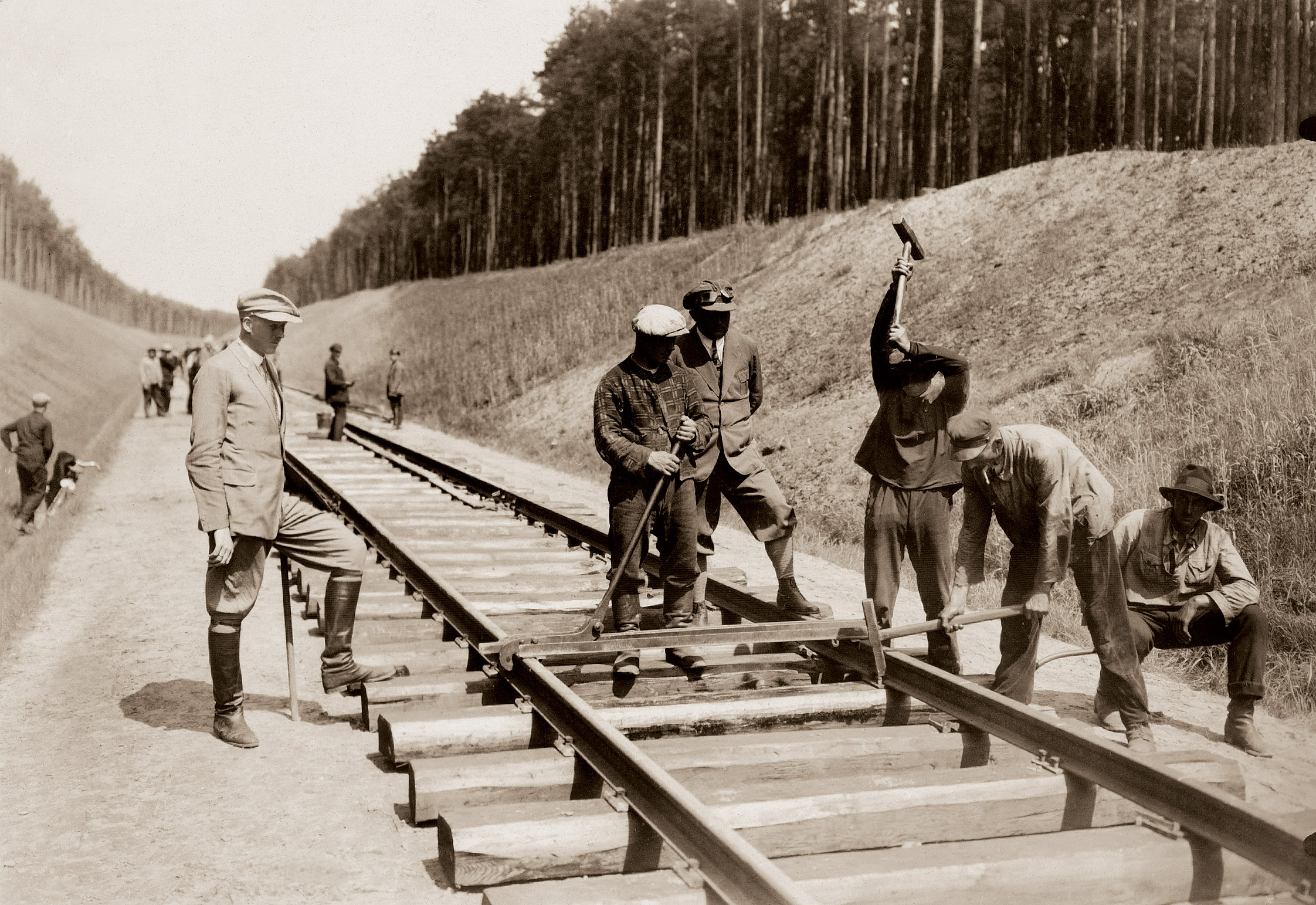
Budowa magistrali węglowej była jedną z głównych inwestycji kolejowych okresu międzywojennego w Polsce / The construction of the coal mine was one of the main railway investments in Poland in the interwar period
Wagony lodownie chłodzone suchym lodem
W 1927 roku wprowadzono system transportu towarów łatwo psujących się. Przewozy odbywały się w wagonach lodowniach po wyznaczonych trasach, wzdłuż których na większych stacjach (również granicznych) urządzano magazyny lodu suchego. Pozwalało to, przy użyciu 550 wagonów (1939), na prowadzenie transportu tranzytowego, np. mięsa z Rumunii do Francji, ryb z Łotwy do Polski, mięsa z Polski do Niemiec, Francji i Szwajcarii, bekonów, drobiu, masła i jaj do Anglii. Najdłuższa trasa licząca 1225 kilometrów z Zaleszczyk do portu w Gdyni była pokonywana przez pociągi z wagonami chłodzonymi suchym lodem w kilka dni. Jedyna wytwórnia suchego lodu znajdowała się w Krynicy, skąd w specjalnych pojemnikach był on dostarczany do punktów magazynowych. Pociągi tego typu, jeszcze za czasów cesarsko-królewskiej monarchii, trasę ze Stanisławowa do Wiednia pokonywały w 54 godziny, ze Lwowa – w 43 godziny, a z Krakowa – w 18 godzin. PKP rocznie transportowało nawet 85,9 miliona ton towarów (1929).
Kurierskie i luksusowe przed pasażerskimi
W okresie międzywojennym wyróżniano stopnie ważności pociągów. Na pierwszym miejscu były pociągi ratunkowe jadące do wypadków, a następnie: pierwszego stopnia starszeństwa (luksusowe, kurierskie, pośpieszne), drugiego stopnia (pasażerskie przyspieszone, pasażerskie, podmiejskie, mieszane osobowo-towarowe, wojskowe i sanitarne, służbowe, inspekcyjne), trzeciego stopnia (mieszane towarowo-osobowe, towarowe pośpieszne, towarowe żywnościowe, towarowe dalekobieżne) i czwartego stopnia (towarowe zbiorowe, zdawcze). Spośród pociągów o znaczeniu międzynarodowym przez Polskę kursował m.in. Nord Express z Paryża (Calais i Ostendy) przez Kolonię, Hanower, Berlin (tu był dzielony na trzy części), Frankfurt n. Odrą, Poznań, Kutno do Warszawy. Druga część z Berlina przez Frankfurt n. Odrą, Krzyż, Piłę, Chojnice, Tczew, Malbork, Królewiec, Kowno jechała do Rygi. Trzecią część składu z Berlina kierowano przez Frankfurt n. Odrą, Wrocław, Opole, Bytom, Katowice, Kraków, Lwów, Stanisławów, Czerniowce do Bukaresztu.
Szybkie jak strzały
Międzywojenne Polskie Koleje Państwowe nie muszą się do dziś wstydzić szybkości przewozów. Największa prędkość pociągu prowadzonego parowozem – 110 km/h – dopuszczona była na odcinku Poznań-Zbąszyń. Z prędkością 100 km/h poruszały się składy na trasie Łapy-Białystok-Grodno-Wilno i Warszawa-Radom. Natomiast składy „motorowe” mogły osiągać szybkość 120 km/h, jadąc z Warszawy do Katowic, do Łodzi Fabrycznej, Łap i Poznania. Ich prędkości handlowe na odcinku Warszawa-Koluszki wynosiły nawet 95,8 km/h. Najszybszy pod koniec dwudziestolecia był Nord Express, którego trasę przedłużono do Moskwy. Na odcinku Zbąszyń-Poznań jego prędkość handlowa wynosiła 93,4 km/h, a na odcinku Warszawa-Stołpce 84,6 km/h. Z Warszawy do Berlina pociąg ten jechał 7 godzin i 15 minut.
Dworzec Warszawa Główna
Ważną realizacją w międzywojniu była budowa dworca Warszawa Główna (1931–1939), posadowionego nad ośmioma torami ułożonymi w wykopie. Projekt profesorów Czesława Przybylskiego i Andrzeja Pszenickiego przewidywał wykonanie stalowej, nitowanej konstrukcji z żelbetową płytą nad torami. Na niej stanąć miały budynki o długości 130×85 metrów, z główną halą dla odjeżdżających, wysoką na 26 metrów i halą dla przyjeżdżających o wysokości 14 metrów, połączonych pięciokondygnacyjnym budynkiem przeznaczonym na biura.
Sukces 20 letniego wysiłku
Dzięki wysiłkowi organizacyjnemu w ciągu niecałych 20 lat udało się wprowadzić sprawnie działające władze i służby kolejowe, scalić odrębne systemy transportowe funkcjonujące pod trzema zaborami, uruchomić własny przemysł taboru kolejowego, wykształcić kadrę pracowniczą, przebudować i polepszyć stan techniczny linii kolejowych, zwiększyć prędkości pociągów i osiągnąć wysoką punktualność kursowania. Kolejarze stanowili silną grupę zawodową, wśród nich maszyniści byli uważani za elitę. Na PKP działało 16 związków zawodowych, oprócz tego stowarzyszenia samopomocowe, takie jak np. Rodzina Kolejowa. Ukazywały się pisma branżowe dla poszczególnych służb. W „Technice Parowozowej”, dodatku do pisma „Maszynista” (organu Związku Zawodowego Maszynistów), ogłoszono w 1929 roku konkurs na najpiękniejszy parowóz PKP. Wygrał Ok22, „ponieważ głosy przemawiające za pięknością tego parowozu podkreślają okazałość i prezencję; piękna budowa tworzy harmonijną całość; trzy koła wiązane, dwa koła wózkowe, w zespole z delikatnym mechanizmem (ruchowym i rozrządu pary) dają ładny wygląd; kształtna dymnica, ładny wąski zbiornik i piasecznica, proporcjonalny krótki komin, piękna ukośna budka, ładny lakier podnosi piękno, udatne położenie kotła, efektowność w biegu”. Słowa te świadczą o miłości, jaką kolejarze obdarzali swoje maszyny.
… i kilka porażek
Nie wszystko było jednak takie piękne. Głośnym echem odbił się w 1935 roku chybiony, acz kosztowny zakup 3300 kompletów francuskich przyrządów Pyram do bezdymnego spalania węgla w parowozach. Urządzenia kosztowały 35 milionów franków, a ich zainstalowanie kolejny milion. Aparaty podające parę do paleniska (zmniejszając udział powietrza w spalaniu węgla) i do dymnicy (w celu zapobieżenia iskrzeniu), miały dodatkowo zapewniać oszczędności w zużyciu paliwa. Zasada była podobna jak w stosowanych w małej skali przyrządach Langnera, lecz ze zwiększonym stopniem automatyzacji. Awaryjne, drogie i zawodne urządzenia o złożonej obsłudze nie przyczyniły się ani do poprawy jakości pracy parowozów, ani do oszczędności węgla.
Wkracza trakcja spalinowa
Po zaborcach pozostała na PKP niewielka liczba różnego rodzaju pojazdów motorowych. Najliczniejszą grupę stanowiło 20 dwuwagonowych zespołów akumulatorowych Wittfelda (budowanych w latach 1907-1914), mających zasięg do 130 kilometrów i zabierających 150 pasażerów. Kursowały w dyrekcji poznańskiej i toruńskiej. Na terenie dyrekcji krakowskiej jeździło pięć dwuosiowych wagonów parowych Komareka trzeciej klasy, mających 32 miejsca siedzące. Woziły pasażerów na trasie ze Skarżyska do Ostrowca Świętokrzyskiego, Radomia i Końskich. W 1928 roku kupiono parowy wagon Clayton dla linii Tarnów-Szczucin. W tym samym czasie Zakłady Lilpop, Rau i Loewenstein z podzespołów firmy Sentinel-Camel zmontowały wagon samobieżny dla linii Puck–Hel, a „Cegielski” w 1931 roku dostarczył na podstawie zmodyfikowanej dokumentacji dziewięć wagonów z napędem parowym. Podejmowane były zatem różne próby rezygnacji z parowozów, ale nadal były to pojazdy napędzane parą.
Testy wagonów
Pierwsze wagony motorowe pojawiły się na kolejach wąskotorowych: wilanowskiej i gnieźnieńskiej. W 1926 roku takie wagony kupiła w Niemczech kolejka wilanowska. Czteroosiowe wagony samobieżne produkowały Zakłady Lilpopa. Warsztaty Warszawskich Kolejek Dojazdowych także zbudowały pewną liczbę wagonów i małych lokomotyw spalinowych różnych konstrukcji. Natomiast pierwszy normalnotorowy wagon spalinowy Ganz z wagonem doczepnym rozpoczął w 1928 roku kursowanie na linii Kraków-Kocmyrzów. Równocześnie eksperymentowano z wysoce awaryjnym wagonem spalinowym, wyprodukowanym w 1910 roku przez firmę DüsseldorferEisenbahnbedarf. Mimo generalnej przebudowy w 1931 roku, nie osiągał on zadowalających wyników i został wycofany.
Lata 1931-1932 to czas testowania różnych modeli wypożyczanych od producentów, które jednak nie spełniały oczekiwań. W 1933 roku austriacka wytwórnia Austro-Daimler-Puch zaoferowała wagon motorowy T2x640 H4 z dwoma silnikami benzynowymi i kołami wyposażonymi w pneumatyczne opony, które amortyzowały wstrząsy podczas jazdy. Wagon pomyślnie przeszedł próby i został kupiony dla motowagonowni w Krakowie. Ze względu na wydłużony kształt nazywano go lukstorpedą.
Lukstorpedy i inne konstrukcje spalinowe
Dobre osiągi tej maszyny skłoniły krajowych wytwórców do zainteresowania się produkcją wagonów spalinowych. Po wprowadzeniu ulepszeń i zmian na podstawie zmodernizowanej austriackiej dokumentacji zakłady w Chrzanowie wyprodukowały w 1936 roku pięć lukstorped. Maszyny wzbogaciły tabor PKP po testowych jazdach z Krakowa do Zakopanego, Krynicy, a także do Warszawy i Lwowa. Maksymalną prędkość podróżowania ustalono na 115 km/h. Jazda lukstorpedą z Krakowa do Zakopanego znacznie skracała czas podróży. Chociaż jednostka zajeżdżała do Rabki, pokonanie całej trasy zajmowało 2 godziny i 18 minut. Wagon lukstorpedy miał na obu końcach kabiny sterownicze. Przy dwukrotnej zmianie kierunku jazdy na tej linii maszynista przechodził z kabiny na jednym końcu wagonu do drugiej.
Nowe konstrukcje pojawiły się również w innych krajowych wytwórniach. Zakłady Lilpop, Rau i Loewenstein dostarczyły w 1934 roku dwa wagony motorowe czteroosiowe i 12 dwuosiowych wraz z wagonami doczepnymi, zakłady Cegielskiego do 1939 roku wyprodukowały 28 wagonów motorowych czteroosiowych z silnikami Saurer, a Zakłady Huta Królewska i Laura zbudowały wagon z silnikiem Diesel-Simmering. Chrzanowski Fablok rozpoczął przygodę z trakcją spalinową od realizacji zamówienia dla Polskich Kolei Państwowych na 10 drezyn z zamkniętym nadwoziem i 10 z otwartym (1930). Pierwszą krajową lokomotywą spalinową była chrzanowska G1C, dwuosiowa z 60-konnym silnikiem Diesel-Warchałowski (1930). Niestety, nie sprawdziła się na kopalnianej bocznicy ze względu na zbyt słaby silnik i powróciła do producenta. Dla prywatnych odbiorców, na podstawie kupionej w fabryce Deutz dokumentacji, Fablok wyprodukował 12 lokomotyw normalnotorowych dwuosiowych trzech typów, jedną trójosiową i jeden prototyp.
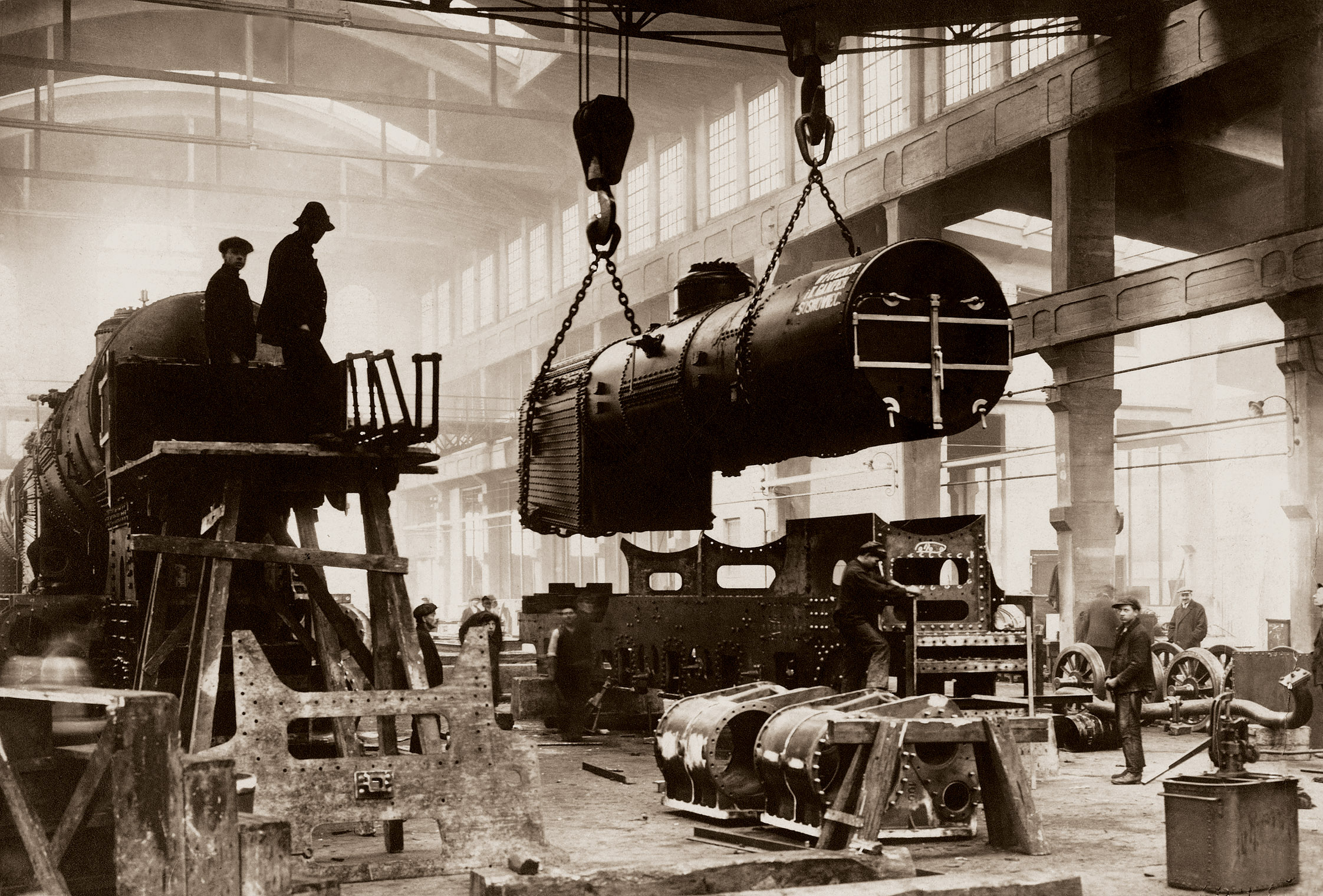
Wnętrze hali montażu w Pierwszej Fabryce Lokomotyw w Polsce - Chrzanów, lata 20. XX w. / Inside the assembly room of the First Steam Locomotives Factory in Poland in Chrzanów - 1920s
Elektryczne na szlaku
Linie kolejowe w Warszawie wychodziły z miasta promieniście i zostały połączone obwodnicą. Stolica odrodzonego państwa domagała się usprawnienia komunikacji. W 1918 roku Ministerstwo Kolei (jeszcze pod okupacją niemiecką) powołało Komisję ds. Przebudowy Warszawskiego Węzła Kolejowego na czele z profesorem Aleksandrem Wasiutyńskim. Efektem jej prac była przyjęta przez sejm w lipcu 1919 roku ustawa o przebudowie węzła kolejowego warszawskiego, podpisana wraz z dekretem o wywłaszczaniu gruntów pod tę inwestycję przez Naczelnika Państwa Józefa Piłsudskiego.
Ruch towarowy miał być prowadzony starą linią obwodową, natomiast ruch pasażerski tzw. linią średnicową, przechodzącą przez śródmieście stolicy, mostem przez Wisłę, do stacji Warszawa Wschodnia. Wybudowano prowizoryczny dworzec Warszawa Główna, stacje postojowe Warszawa Szczęśliwice i Warszawa Grochów. Tory przeprowadzono przez centrum wykopem i tunelem na długości kilometra pod Alejami Jerozolimskimi i dalej nowym mostem przez Wisłę. Pojawił się wszakże istotny problem: parowozy nie mogły poruszać się w długim tunelu. Miało to decydujący wpływ na podjęcie prac elektryfikacyjnych w węźle warszawskim.
Elektryfikacja węzła warszawskiego
W 1919 roku profesor Roman Podoski utworzył międzyministerialne Biuro Studiów Elektryfikacji Kolei. Na podstawie analiz w 1921 roku przyjęto system prądu stałego o napięciu 3 kV, uzyskiwanego z podstacji prostownikowych, rozmieszczanych wzdłuż linii, co około 25 kilometrów. Nakłoniono rząd do etapowej elektryfikacji całego węzła warszawskiego i przystąpiono do opracowania szczegółowych projektów. Dostawcami sprzętu i taboru zostały firmy angielskie: English Electric i Metropolitan Vickers. Anglicy utworzyli komitet techniczno-handlowy ContractorsCommittee for the Electrification of PolishRailways i otworzyli biuro w Warszawie. Wszystko, co mogło być wykonane w kraju, zgodnie z umową, produkowano na miejscu.
W trzy lata wykonano olbrzymią pracę. Przebudowano i zelektryfikowano 106 kilometrów linii, 12 stacji i 18 przystanków, 100 kilometrów linii zasilających, sześć podstacji trakcyjnych, 260 kilometrów sieci trakcyjnej, wybudowano dwie elektrowozownie i główne warsztaty elektrotrakcyjne. Do obsługi zbudowano 76 trójwagonowych jednostek elektrycznych E91 i E92, wyposażonych w angielską aparaturę, zabierających 536 pasażerów. Ponadto wyprodukowano sześć czteroosiowych lokomotyw EL.100 typu „cięższego” (w tym 4 sztuki zbudowane w Chrzanowie) i cztery czteroosiowe lokomotywy EL.200 typu „lekkiego”, zbudowane w zakładach Cegielskiego. 15 grudnia 1936 roku został otwarty pierwszy zelektryfikowany odcinek Pruszków-Warszawa-Otwock. Pół roku później pociąg elektryczny wjechał do Grodziska i Żyrardowa, a w grudniu 1937 roku – do Mińska Mazowieckiego.
Oprócz elektryfikacji sieci kolejowej przed wybuchem wojny, Polskie Koleje Państwowe wprowadzały z dużym rozmachem nowoczesne urządzenia teletechniczne. Układane były kable linii teletechnicznych, wprowadzono dalekopisy, nowe centrale automatyczne, urządzenia telefoniczne, dyspozytorskie i zabezpieczenia kas, sieci napowietrzne, itp. Od 1927 roku w Warszawie funkcjonowała prywatna Elektryczna Kolej Dojazdowa na prąd stały o napięciu 600 V. Obsługiwała podmiejski ruch pasażerski na trasie Warszawa-Komorów-Podkowa Leśna-Grodzisk Mazowiecki, z dobudowanymi połączeniami do Włoch i Milanówka.